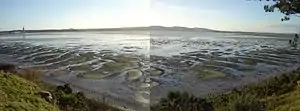Montrose Basin
Montrose Basin is a nearly circular tidal basin which makes up part of the estuary of the River South Esk and which sits just inland of the town of Montrose in Angus on the east coast of Scotland.[2] The basin is protected by a number of designations, it is managed by the Scottish Wildlife Trust as a Wildlife Reserve,[3] as well as being designated as a Local Nature Reserve,[4] Site of Special Scientific Interest,[2] a Special Protection Area[5] and a Ramsar Site.[1]
| Designations | |
|---|---|
| Official name | Montrose Basin |
| Designated | 3 February 1995 |
| Reference no. | 716[1] |

Habitat
The enclosed tidal basin has a variety of habitats within it from exposed tidal mudflats to saltmarsh, reedbed and fen and its surrounded by arable farmland and pasture. The section of the basin at Maryton is an important site for the study of the sea level fluctuations following the end of the last glaciation.[2] The SPA includes the small, eutrophic freshwater loch called Dun's Dish.[5] The basin contains the largest area of saltmarsh in Angus.[2]
Wildlife
The extensive mudflats are home to large populations of invertebrates, especially annelid worms, the snail Hydrobia and the amphipod Corophium. There are also beds of mussels Mytilus edulis. The flora includes beds consisting of three species of eel grass, Zostera, and algae. The mudflats support numbers of waders and wildfowl including Eurasian oystercatcher, common redshank, red knot, mute swan, Eurasian wigeon and common eider. Large flocks of pink-footed goose and greylag goose use the basin to roost in and feed in the surrounding farmland. As well as wintering eiders the basin supports a large breeding population.[2] In all 213 species of bird have been recorded on the basin, most being winter visitors or passage migrants and just over 50 species are thought to breed.[4]
A visitor centre was opened on the south side of the basin at Rossie Braes[3] by the Scottish Wildlife Trust in 1995.[4]
History
The Montrose Basin Heritage Society was formed in 1999 to bring together information about the basin, including its history and archaeology. The oldest evidence for humans in the area dating back as far as over 3,000 year B.C.E., this being the linear monument, known as the cursus, which runs from Powis to Old Montrose.[6]
The Basin has been exploited for its seafood, especially the Atlantic salmon but commercial fisheries for this species ended in 2018;[7] and mussel cultivation gave it the largest mussel beds in the country during the 19th and early 20th centuries.[8]
The Montrose Basin was hit by a tsunami in 6100 BC, generated by the massive underwater Storegga Slide, in Norway. It was 70 feet (21 m) high when it hit the basin, with the waters travelling inland as far as Forfar.[2]
References
- "Montrose Basin". Ramsar Sites Information Service. Retrieved 25 April 2018.
- "Montrose Basin SSSI". Scottish Natural Heritage. Retrieved 13 March 2020.
- "Montrose Basin". Scottish Wildlife Trust. Retrieved 13 March 2020.
- "Montrose Basin LNR". Montrose Basin .org. Retrieved 13 March 2020.
- "Montrose Basin SPA". Scottish Natural Heritage. Retrieved 13 March 2020.
- "Montrose Bay Heritage Society". Montrose Bay Heritage Society. Retrieved 13 March 2020.
- "Last Scottish wild salmon facility closes - as there are so few fish to catch". The Scotsman. 2 December 2018. Retrieved 13 March 2020.
- David W. McKay & Sarah L. Fowler (1997). "Review of the Exploitation of the Mussel, Mytilus edulis, in Scotland" (PDF). Scottish Natural Heritage.
External links
- Reserve's website
- Montrose Basin Live Webcam
- Visitor Centre information
- DEFRA report
- Map sources for Montrose Basin